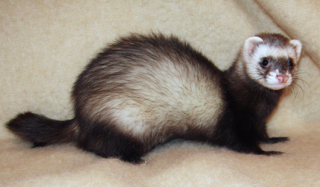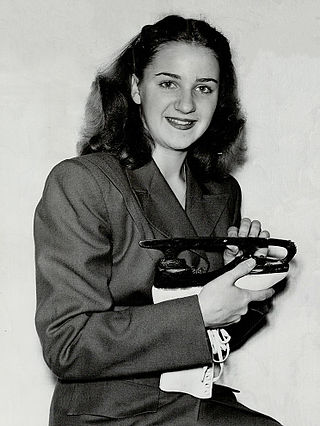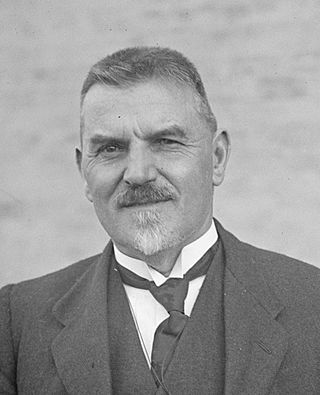Related Research Articles

Veterinary medicine is the branch of medicine that deals with the prevention, management, diagnosis, and treatment of disease, disorder, and injury in non-human animals. The scope of veterinary medicine is wide, covering all animal species, both domesticated and wild, with a wide range of conditions that can affect different species.

The ferret is a small, domesticated species belonging to the family Mustelidae. The ferret is most likely a domesticated form of the wild European polecat, as evidenced by the ferrets ability to interbreed with European polecats and produce hybrid offspring. Physically, ferrets resemble other mustelids because of their long, slender bodies. Including their tail, the average length of a ferret is about 50 cm (20 in); they weigh between 0.7 and 2.0 kg ; and their fur can be black, brown, white, or a mixture of those colours. The species is sexually dimorphic, with males being considerably larger than females.

A gelding is a castrated male horse or other equine, such as a pony, donkey or a mule. The term is also used with certain other animals and livestock, such as domesticated camels. By comparison, the equivalent term for a castrated male bull would be ox, or a wether for rams and billy goats.

A veterinarian (vet) is a medical professional who practices veterinary medicine. They manage a wide range of health conditions and injuries in non-human animals. Along with this, veterinarians also play a role in animal reproduction, health management, conservation, husbandry and breeding and preventive medicine like nutrition, vaccination and parasitic control as well as biosecurity and zoonotic disease surveillance and prevention.

An avian veterinarian is a veterinarian who specializes in treating birds. All veterinarians, upon first qualification from a certified veterinary college, may treat any species. Additional training is required for qualification to become a recognized specialist in the care of birds.

A zookeeper, sometimes referred as animal keeper, is a person who manages zoo animals that are kept in captivity for conservation or to be displayed to the public. They are usually responsible for the feeding and daily care of the animals. As part of their routine, the zookeepers may clean the exhibits and report health problems. They may also be involved in scientific research or public education, such as conducting tours and answering questions.

The New York State College of Veterinary Medicine at Cornell University is a college of veterinary medicine at Cornell University, in Ithaca, New York. It was founded in 1894. It is the first statutory college of the State University of New York (SUNY) system.

The American Veterinary Medical Association (AVMA), founded in 1863, is a not-for-profit association representing more than 99,500 veterinarians in the US.

A feral cat or a stray cat is an unowned domestic cat that lives outdoors and avoids human contact: it does not allow itself to be handled or touched, and usually remains hidden from humans. Feral cats may breed over dozens of generations and become an aggressive local apex predator in urban, savannah and bushland environments. Some feral cats may become more comfortable with people who regularly feed them, but even with long-term attempts at socialization, they usually remain aloof and are most active after dusk. Of the 700 million cats in the world, an estimated 480 million are feral.

Onychectomy, popularly known as declawing, is an operation to remove an animal's claws surgically by means of the amputation of all or part of the distal phalanges, or end bones, of the animal's toes. Because the claw develops from germinal tissue within the third phalanx, amputation of the bone is necessary to fully remove the claw. The terms onychectomy and declawing imply mere claw removal, but a more appropriate description would be phalangectomy, excision of toe bone.

Dermatophytosis, also known as ringworm, is a fungal infection of the skin. Typically it results in a red, itchy, scaly, circular rash. Hair loss may occur in the area affected. Symptoms begin four to fourteen days after exposure. Multiple areas can be affected at a given time.

The Silver Spring monkeys were 17 wild-born macaque monkeys from the Philippines who were kept in the Institute for Behavioral Research in Silver Spring, Maryland. From 1981 until 1991, they became what one writer called the most famous lab animals in history, as a result of a battle between animal researchers, animal advocates, politicians, and the courts over whether to use them in research or release them to a sanctuary. Within the scientific community, the monkeys became known for their use in experiments into neuroplasticity—the ability of the adult primate brain to reorganize itself.

Suzanne Morrow Francis was a Canadian figure skater and veterinarian. She competed in Ladies' Singles in the 1948 and 1952 Winter Olympics. Between 1947 and 1948, Francis competed in Pairs Mixed competitions with Canadian figure skater Wallace Diestelmeyer. Together they won the bronze medal at the 1948 Winter Olympics and the 1948 World Figure Skating Championships. They were the first pair team to perform the death spiral one-handed, with the man holding the woman in position with one hand, at the 1948 Olympic Games.

Sir Arnold Theiler KCMG Pour le Mérite is considered to be the father of veterinary science in South Africa. He was born in Frick, Canton Aargau, Switzerland. He received his higher education, and later qualified as a veterinarian, in Zurich. In 1891, Theiler travelled to South Africa and at first found employment as a farm worker on Irene Estates near Pretoria, owned by Nellmapius, but later that year started practising as a veterinarian.

Promazine, is used as a short-term add-on treatment for psychomotor agitation. Its approved uses in people is limited, but is used as a tranquilizer in veterinary medicine. It has weak antipsychotic effects but is generally not used to treat psychoses.

Ernst Friedrich Gurlt was a German veterinarian and anatomist born in Drentkau near Grünberg, Silesia. He was the father of surgeon Ernst Julius Gurlt (1825-1899).

Lenperone (Elanone-V) is a typical antipsychotic of the butyrophenone chemical class. It was first reported as an anti-emetic in 1974, and its use in treatment of acute schizophrenia was reported in 1975. Related early antipsychotic agents include declenperone and milenperone.

William Youatt was an English veterinary surgeon and animal welfare writer.

Veterinary medicine in the United States is the performance of veterinary medicine in the United States, normally performed by licensed professionals, and subject to provisions of statute law which vary by state. Veterinary medicine is normally led by veterinary physicians, termed veterinarians or vets, but also by paraveterinary workers, such as veterinary technicians, and veterinary assistants. This can be augmented by other paraprofessionals with specific specialties, such as animal physiotherapy or dentistry, and species-relevant roles such as farriers.
References
- ↑ Bowman, Dwight D. (4 Nov 2008). Georgis' Parasitology for Veterinarians (9nt ed.). Saunders. p. 187. ISBN 978-1-4160-4412-3.
- ↑ Gurltia paralysans (Wolffhügel, 1933): description of adults and additional case reports of neurological diseases in three domestic cats from southern Chile. Moroni M, Muñoz P, Gómez M, Mieres M, Rojas M, Lillo C, Aguirre F, Acosta-Jamett G, Kaiser M and Lindsay DS, Vet Parasitol., 23 MArch 2012, volume 184, issues 2–4, pages 377–380, doi : 10.1016/j.vetpar.2011.08.035